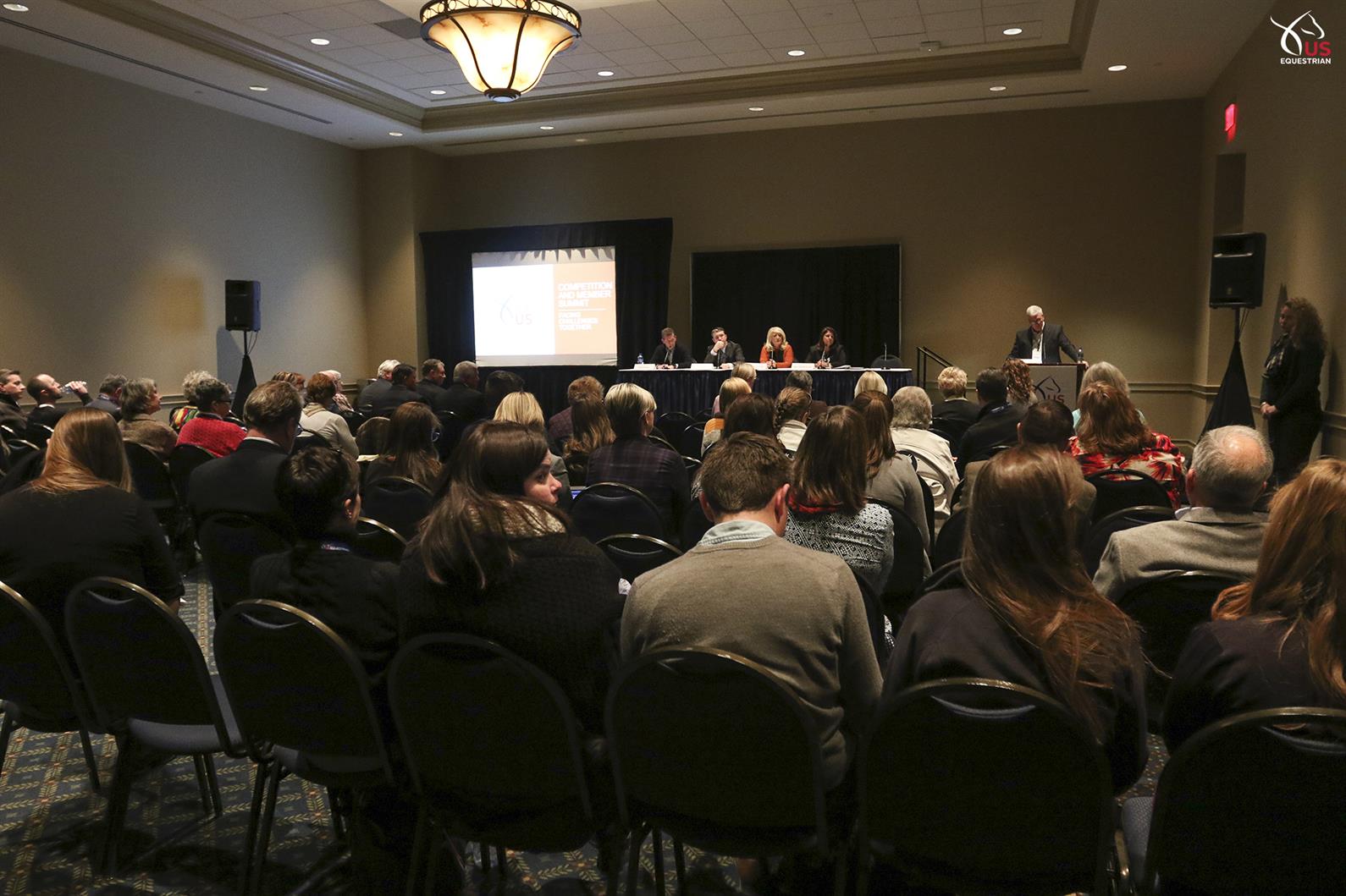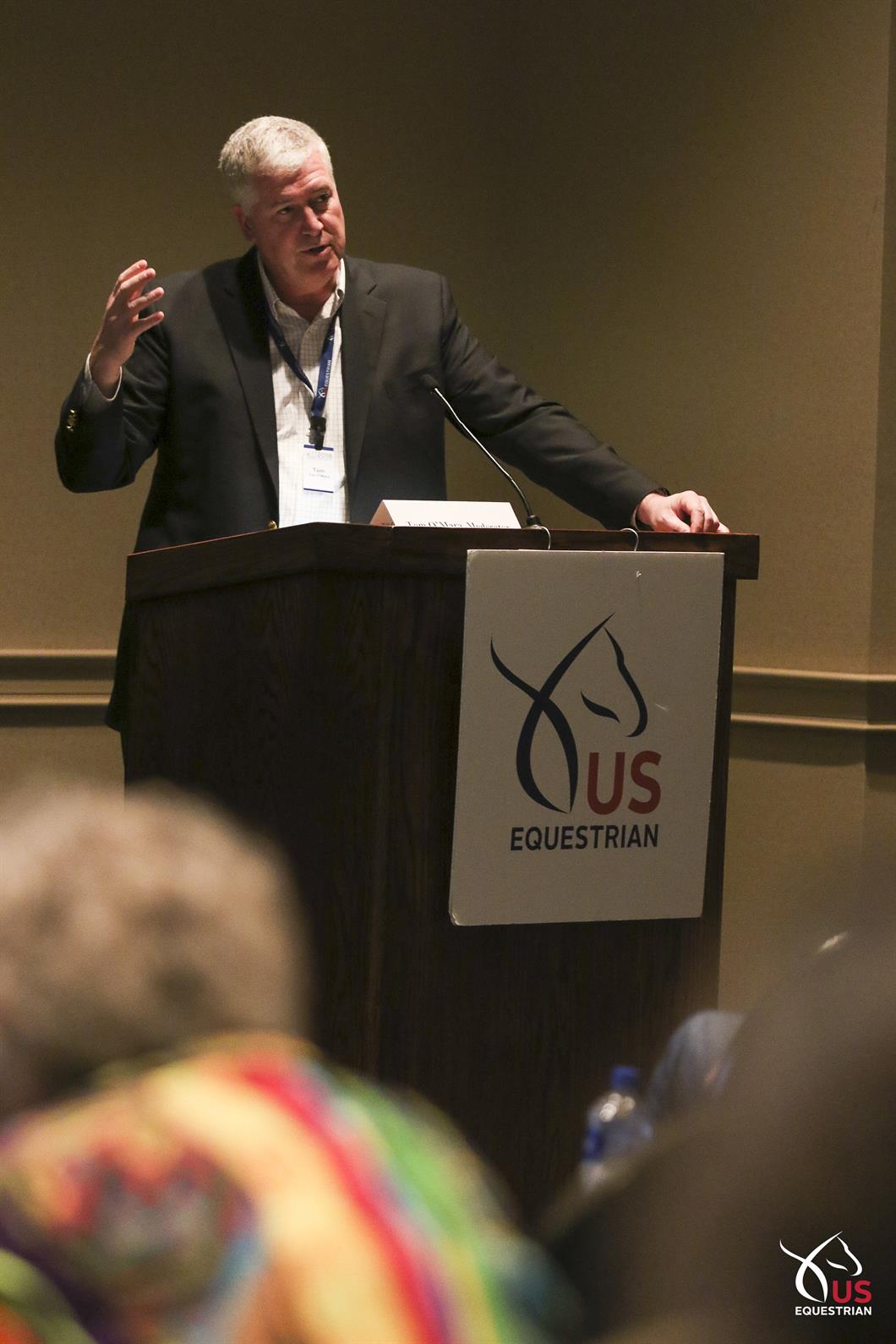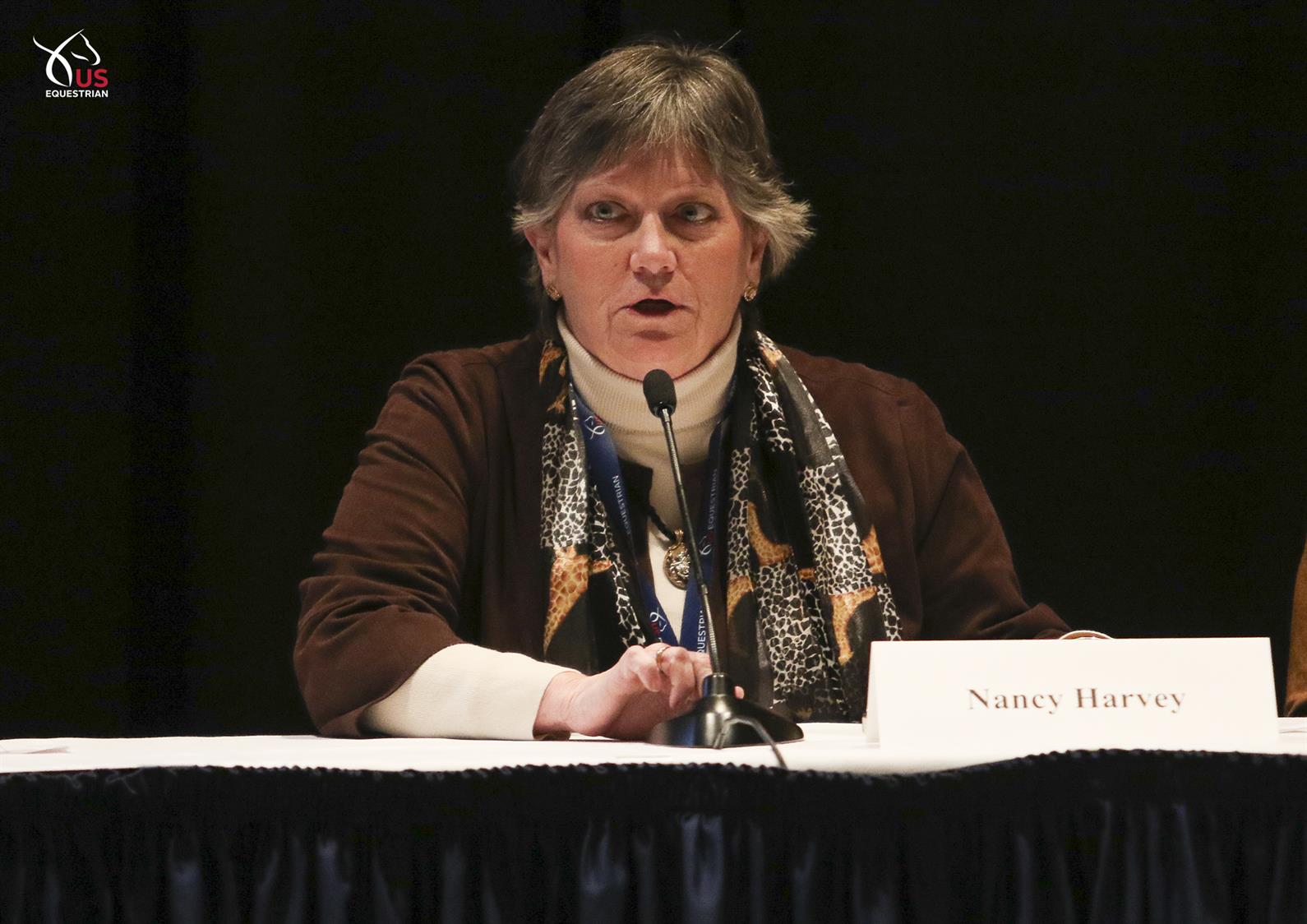US Equestrian’s "Competition & Member Summit: Facing Challenges Together" got the organization’s Jan. 17-20 Annual Meeting started a day early on Tuesday in Lexington, Ky. The summit grew out of feedback from US Equestrian’s members, competition organizers, licensed officials, experts, and staff. It brought the equestrian community together to address some of the issues expressed by individual members, licensed officials, competition organizers, experts, and staff throughout the competition year.

The goal was to provide tools that these groups can use to tackle broad challenges faced by the industry. Topics included licensing, calendar management, mileage concerns, lowering barriers to entry for management and competitors to help grow the sport, defining priorities and upholding competition standards across disciplines, and assessing the amounts of prize and bonus money that should be offered at each level of competition. The summit included four panel discussions moderated by US Equestrian board member Tom O’Mara.
A video of the panels and the insurance presentation will be posted on USEF Network’s Annual Meeting page at USEquestrian.org.
Competition Organizer Challenges: Calendar Management
Panelists:
Kim Aldrich-Farrell, Competition Manager, Fox Lea Farm
Rob Burk, CEO United States Eventing Association
Donna Pettry-Smith, President, American Saddlebred Horse Association
Tom Struzzieri, President and CEO, HITS, Inc.
Across all breeds and disciplines, it’s clear there is no “one size fits all” option for calendar management. Some use mileage as a way to manage their calendars, while others start their calendar work at the area or regional level. Each breed and discipline is unique not only in their sport, but also in the challenges they face when developing and managing their competition calendar.
The panel shared their own best practices and preferred ways of working, whether for upper-level events or for grassroots competitions. In the three-day eventing world, for example, USEA’s Burk noted, the competition calendar is largely structured off of the “backbone” of major events like the Land Rover Kentucky Three-Day Event CCI4*, with the grassroots calendar leading up to showcase national events rather than a national organization dictating a calendar. USEA has approximately 240 recognized events around the country that feed into an overall calendar.
“We believe the people in the local area, the local region, know their event and the calendar and the issues affecting it better than we would,” Burk said.
Pettry-Smith, who also is president of the Illinois American Saddlebred Pleasure Horse Association—a charter club of the ASHA—noted that local and interstate cooperation also was key to preventing calendar conflicts for groups like her Illinois organization. “The Illinois and Wisconsin groups work together to try and make our calendar so that the trainers can go to the horse shows that they all want to go to, and we try not to step on top of each other,” Pettry-Smith explained.

(Photo: Taylor Pence)
There are also four different groups putting on multiple local shows in her Chicago area for 100-200 horses. “So we have all of our managers of our horse shows coordinate their schedules so that all of our horse shows aren’t on top of each other,” she said.
That kind of cooperation can help groups prosper collectively and give trainers and competitors more opportunity. And that brings to mind a larger issue: growing equestrian sport.
“Our biggest issue is, where are the clients?” said Struzzieri. “That’s not just in our sport but in many sports. So people are doing it, but we’re not getting enough to the events. So how do we, as show promoters, get the clients out to the events?”
In the hunter jumper world, Struzzieri added, “We base our sanctioning on hunter prize money or those kinds of things, and that’s so antiquated. It’s time to change that.”
“In the wintertime in Florida, yes, we have a large density of horses, but we don’t have any type of A-rated shows January through March,” agreed Aldrich-Farrell of Fox Lea farm in Florida. “We just havethe premier shows. … Where are the double-A junior hunters and the ponies? The numbers are decreasing.”
“I’m of the feeling, and I believe a lot of other people are, that we’re going to grow things from the grassroots up,” said Pettry-Smith. “That’s where I’m working with my charter club. … We’ve all realized that we’re going to have to work together to grow the industry.”
Among the other topics the panel discussed included waivers for competitions and the classification system for rating horse shows.
Costs of Competing and Participating in Equestrian Sport
Panelists:
Elisabeth Goth, Vice-President, US Equestrian Board of Directors
Nancy Harvey, President, Arabian Horse Association
Cindy Mugnier, Member, US Equestrian Board of Directors
Lynn Walsh, President, Pin Oak Charity Horse Show
One factor that can discourage equestrians from competing: the cost. Costs and fees associated with competing are often seen as a major deterrent to amateurs and parents with equestrian children who wish to attend recognized horse shows. Riding and showing can be expensive, and as a community it’s our duty to evaluate our sport and identify ways to keep costs down for competitors without sacrificing quality. As this panel revealed, there is a limited number of players on each side of the business, and there was general agreement that it’s beneficial to build a culture of openness and transparency around where the money goes and how it’s used. And not just transparency, but also education about both the costs competition organizers bear and the benefits that also come with recognized competitions.
“Sometimes I think we forget, as exhibitors, what it costs the competitions to put them on,” said Goth. “They have to provide the stalls, the water, the electricity, the footing, the safety things that go into putting in a good event. … It’s one of the reasons I like to show at USEF-rated shows. I want to compete on a level playing field with horses that are under our drugs and medications rules.

“Yes, it can be expensive, but I also feel that if you’re doing any sport at any competitive level, there is an expense,” she added. “We tend to look at things in a vacuum sometimes and forget what we’re provided with and the opportunities we have in this industry.”
“It’s not what we pay; it’s what we get,” added the AHA’s Harvey, who called for more promotion of the benefits of USEF-licensed shows and their benefits. But she also noted that unrated shows—such as local breed shows—that are seeing growth could provide an opportunity to grow equestrian sports and for USEF shows. “We need to embrace it, because that’s where people are coming from,” she said.
One USEF program on the horizon that is poised to grow grassroots equestrian sport is Competition Lite, which is working with affiliates to provide a less expensive stepping-stone to USEF competitions.
In the meantime, USEF board member Mugnier said, it’s important to promote the benefits USEF licensing provides to competitors, such as safety, fairness, and welfare for equestrian and horse.
And keep it fun, urged Pin Oak’s Walsh.
“That’s one thing we’ve tried to do at Pin Oak,” she said. “It’s very welcoming and warm, we know kids’ names, and that has been a big help … people feel appreciated and valued, and they feel that they’re getting what they’re supposed to, in terms of the quality of the event. You feel like you’re getting your money’s worth.”
During the Q and A with the audience, panelists also discussed Competition Lite, the importance of providing a good overall experience to competitors, and drawing youth into equestrian sport, among other subjects.
Show Standards
Panelists:
Pat Boyle, Founder, Showplace Productions
Connie Davenport, Competition Manager, Golden State Dressage
Frank Madden, Trainer, Old Salem Farm
Charlotte Skinner-Robson, Licensed Official, USEF
Competition standards are a growing and important area of emphasis that impact competitors and competition managers. Although hunter jumper and dressage competitions currently operate with varying requirements and competition standards based on rating or level, more affiliates are recognizing the need for and importance of defining competition standards.
The panelists discussed a wide range of issues, including whether to reduce the number of premier shows in the hunter jumper discipline, whether competitors see enough differentiation between premier and national levels, and whether criteria for show standards should be tweaked or reworked beyond the number of horses at a show or the prize money on offer.
“What is in place is a fairly good framework for what needs to happen to make the differentiation between premier and national levels,” said licensed official Skinner-Robson. “I think there are basic standards that absolutely, across the board, we need to require: safety and welfare of both the horses and athletes. … Also, there needs to be the method in place to equal and fair to all competitors.
“Beyond that, to differentiate between regional one, regional two, national, and premier, what I see coming into play is prize money and amenities that you offer.”
There was also a broad consensus that grassroots opportunity is key.
“I think it’s really important that we nurture our grassroots, and I think we need to make our premier horse shows ones that people aspire to get to,” said Old Salem Farm’s Madden. “And they should be few and far between.
“If we’re going to keep excitement in our sport,” he added. “we need to have horse show managers consciously make a decision, ‘Do I want to make that stretch to be a premier horse show?’ And our clients need to ask themselves, with their trainers’ advice, ‘Can I make that stretch to get to a premier horse show?’”
Boyle of Showplace Productions noted that data-driven ideas, innovation, and customer experience also are key.
“The overall experience is something we’ve heard a lot about today,” he said. “Trying to be innovative and keeping current, having fresh ideas, getting people excited … always trying to be a little bit more creative.”
Those good experiences, Golden State Dressage’s Davenport intimated, could also be key to drawing equestrians into deeper involvement such as becoming members and registering their horses.
Prize Money and Bonus Money
Panelists:
Bob Bell, President and Founder, Classic Company, Ltd.
Andrew Philbrick, Owner, Hunter Farms and Princeton Show Jumping
Michael Stone, President, Equestrian Sport Productions
Stephanie Wheeler, Vice-President of Operations, Blenheim EquiSports
For most competitions, prize money is a factor no matter how big or small; whether it’s the amount allowed for the rating, level, or type or the amount that will attract the type of competitor that is most advantageous to the organizer. Prize money has to be thought out by any competition that offers it. The amount of prize money a competition can offer by rating, level, or type is a known factor that helps us manage the competition calendar. The amount a competition can offer in bonuses or exhibitions is an unknown factor and can affect other competitions within a geographical location.
The panel discussed a variety of questions involving bonus and prize money in exhibition classes, among other related topics.
Panelists agreed that manipulation of prize money to get around rating requirements would be undesirable. They also discussed prize money’s role in growing sport.
Classic Company’s Bell noted, “If we want to grow the sport, having a lot of big-money classes isn’t always the answer, because I find that I get more people going in classes that have a lower entry fee and lower prize money.”
Bell, who said that some equestrians would always go for bigger prize money, used the example of hunter derbies as an example of that disparity. But Blenheim EquiSports’ Wheeler pointed out that hunter derbies also had opened up a new market. “I believe there are a large number of people who have gone out and purchased horses to do the derbies,” she said, “It has opened up a whole new market and made it more interesting for certain people. When you put up the big prize money, they’ll pay the entry fee. They want to see their horse go in that class. So I think there’s definitely place for larger amounts of prize money, though it doesn’t work across the board.”
Big-money events do attract attention for the sport, Equestrian Sports Productions’ Stone said. “If you’re talking about growing attention and interesting, increased prize money helps,” he said. “If you’re talking about getting more people to actually take part in the sport, I don’t think it will have much of an effect, and in some ways it may restrict people from going because they don’t want to compete against the top guys and spend the money. So it depends on what you mean by growing the sport and what you want to get out of growing the sport.”
In any case, Hunter Farms owner Philbrick said, standards and prize money should be considered together. “We should look at the standards and the prize money together in order to come up with a rational progression that will support the sport and that everyone can understand.”


